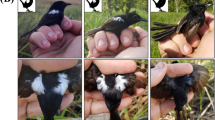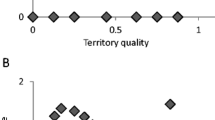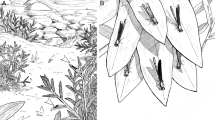Abstract
Female choice can powerfully influence the evolution of male phenotypes. In territorial species, it is challenging to determine the targets of female choice because male traits (e.g., behavior and morphology) are often correlated with territory. We sought to elucidate if and how females specifically evaluate male traits in a territorial species. In this study, we presented female fence lizards, Sceloporus undulatus, with two potential mates to examine mate choice in the absence of territory cues. Females associated more with males possessing better body condition, longer heads, and wider throat badges, and that performed more shudder behavior, which females responded to by approaching shuddering males and performing push-ups. A post hoc decision tree analysis suggests that the strongest predictor of female association was an overall quality index that incorporates all of these traits, rather than individual traits. Male snout–vent length, head width, abdominal badge width, and push-up behavior did not affect female association. Further research on why these traits, which are known to correlate with fitness, do not appear to be used by females when selecting mates would improve our understanding of the evolution of male traits. Our study reveals that females of this territorial species possess the ability to use multiple male traits interactively to make fitness-relevant mate choice decisions in the absence of direct territory cues.




Similar content being viewed by others
References
Alatalo RV, Lundberg A, Glynn C (1986) Female pied flycatchers choose territory quality and not male characteristics. Nature 323:152–153
Andersson M (1994) Sexual selection. Princeton University Press, Princeton
Andersson S, Pryke SR, Ornborg J, Lawes MJ, Andersson M (2002) Multiple receivers, multiple ornaments, and a trade-off between agonistic and epigamic signaling in a widowbird. Am Nat 160:683–691
Arvidsson BL, Neergaard R (1991) Mate choice in the willow warbler—a field experiment. Behav Ecol Sociobiol 29:225–229
Bajer K, Molnar O, Torok J, Herczeg G (2010) Female European green lizards (Lacerta viridis) prefer males with high ultraviolet throat reflectance. Behav Ecol Sociobiol 64:2007–2014
Balmford A, Rosser AM, Albon SD (1992) Correlates of female choice in resource-defending antelope. Behav Ecol Sociobiol 31:107–114
Bart J, Earnst SL (1999) Relative importance of male and territory quality in pairing success of male rock ptarmigan (Lagopus mutus). Behav Ecol Sociobiol 45:355–359
Bennett ATD, Cuthill IC, Norris KJ (1994) Sexual selection and the mismeasure of color. Am Nat 144:848–860
Bookstein FL (1991) Morphometric tools for landmark data: Geometry and biology. Cambridge University Press, Cambridge
Brandt Y (2003) Lizard threat display handicaps endurance. Proc R Soc Lond B 270:1061–1068
Bro-Jørgensen J (2009) Dynamics of multiple signalling systems: animal communication in a world in flux. Trends Ecol Evol 25:292–300
Buchanan KL, Catchpole CK (1997) Female choice in the sedge warbler, Acrocephalus schoenobaenus: multiple cues from song and territory quality. Proc R Soc Lond B 264:521–526
Calf KM, Downs CT, Cherry MI (2003) Territoriality and breeding success in the Cape Sugarbird (Promerops cafer). Emu 103:29–35
Calsbeek R, Sinervo B (2002) Uncoupling direct and indirect components of female choice in the wild. P Natl Acad Sci USA 99:14897–14902
Candolin U (2003) The use of multiple cues in mate choice. Biol Rev 78:575–595
Candolin U (2005) Why do multiple traits determine mating success? Differential use in female choice and male competition in a water boatman. Proc R Soc Lond B 272:47–52
Candolin U, Reynolds JD (2001) Sexual signaling in the European bitterling: females learn the truth by direct inspection of the resource. Behav Ecol 12:407–411
Carey PW (1991) Resource-defense polygyny and male territory quality in the New Zealand fur seal. Ethology 88:63–79
Carpenter CC (1962) Patterns of behavior in two Oklahoma lizards. Am Midl Nat 67:132–151
Carpenter CC, Ferguson GW (1977) Variation and evolution of stereotyped behaviour in reptiles. In: Gans C, Tinkle DW (eds) Biology of the reptilia, vol 7. Academic Press Inc., London, pp 335–554
Castellano S, Rosso A (2007) Female preference for multiple attributes in the acoustic signals of the Italian treefrog, Hyla intermedia. Behav Ecol Sociobiol 61:1293–1302
Ceballos S, Kiorboe T (2010) First evidences of sexual selection by mate choice in marine zooplankton. Oecologia 164:627–635
Chaine AS, Lyon BE (2008) Adaptive plasticity in female mate choice dampens sexual selection on male ornaments in the lark bunting. Science 319:459–462
Clarkson CE (2007) Food supplementation, territory establishment, and song in the Prothonotary Warbler. Wilson J Ornithol 119:342–349
DeBruine LM, Jones BC, Crawford JR, Welling LLM, Little AC (2010) The health of a nation predicts their mate preferences: cross-cultural variation in women's preferences for masculinized male faces. Proc R Soc Lond B 277:2405–2410
Dijkstra PD, van der Zee EM, Groothuis TGG (2008) Territory quality affects female preference in a Lake Victoria cichlid fish. Behav Ecol Sociobiol 62:747–755
Dunlap K, Mathies T (1993) Effects of nymphal ticks and their interaction with malaria on the physiology of male fence lizards. Copeia 1993:1045–1048
Eckerle KP, Thompson CF (2006) Mate choice in house wrens: nest cavities trump male characteristics. Behaviour 143:253–271
Ferguson GW (1971) Behavior and interactions of 2 sympatric Sceloporus in Utah. Am Midl Nat 86:190–196
Ferguson GW, Talent LG (1993) Life-history traits of the lizard Sceloporus undulatus from two populations raised in a common laboratory environment. Oecologia 93:88–94
Ferguson GW, Brinker AM, Gehrmann WH, Bucklin SE, Baines FM, Macklin SJ (2010) Voluntary exposure of some western-hemisphere snake and lizard species to ultraviolet-B radiation in the field: how much ultraviolet-B should a lizard or snake receive in captivity. Zoo Biol 29:317–334
Ferner JW (1976) Notes on natural history and behavior of Sceloporus undulatus erythrocheilus in Colorado. Am Midl Nat 96:291–302
Haenel GJ, Smith LC, John-Alder H (2003a) Home-range analysis in Sceloporus undulatus. II. A test of spatial relationships and reproductive success. Copeia 2002:113–123
Haenel GJ, Smith LC, John-Alder HB (2003b) Home-range analysis in Sceloporus undulatus (eastern fence lizard). I. Spacing patterns and the context of territorial behavior. Copeia 2001:99–112
Halliday T (1983) The study of mate choice. In: Bateson P (ed) Mate choice. Cambridge University Press, Cambridge, pp 3–32
Hamilton PS, Sullivan BK (2005) Female mate attraction in ornate tree lizards, Urosaurus ornatus: a multivariate analysis. Anim Behav 69:219–224
Hamilton WD, Zuk M (1982) Heritable true fitness and bright birds—a role for parasites. Science 218:384–387
Healey M, Uller T, Olsson M (2008) Variety is the spice of life: female lizards choose to associate with colour-polymorphic male dyads. Ethology 114:231–237
Hebets EA, Papaj DR (2005) Complex signal function: developing a framework of testable hypotheses. Behav Ecol Sociobiol 57:197–214
Herrel A, Spithoven L, Van Damme R, De Vree F (1999) Sexual dimorphism of head size in Gallotia galloti; testing the niche divergence hypothesis by functional analyses. Funct Ecol 13:289–297
Herrel A, Van Damme R, Vanhooydonck B, De Vree F (2001) The implications of bite force performance for diet in two species of lacertid lizards. Can J Zool 79:662–670
Hews DK (1990) Examining hypotheses generated by field measures of sexual selection on male lizards, Uta palmeri. Evolution 44:1956–1966
Holland B, Rice WR (1998) Chase-away sexual selection: antagonistic seduction versus resistance. Evolution 52:1–7
Huey RB, Dunham AE, Overall KL, Newman RA (1990) Variation in locomotor performance in demographically known populations of the lizard Sceloporus merriami. Physiol Zool 63:845–872
Hunsaker D (1962) Ethological isolating mechanisms in Sceloporus torquatus group of lizards. Evolution 16:62–74
Huyghe K, Vanhooydonck B, Scheers H, Molina-Borja M, Van Damme R (2005) Morphology, performance and fighting capacity in male lizards, Gallotia galloti. Funct Ecol 19:800–807
Iossa G, Soulsbury CD, Baker PJ, Harris S (2008) Body mass, territory size, and life-history tactics in a socially monogamous canid, the red fox Vulpes vulpes. J Mammal 89:1481–1490
James SE, M'Closkey RT (2004) Patterns of body size and habitat use in a lizard assemblage. Ecoscience 11:160–167
Johnstone RA (1996) Multiple displays in animal communication: 'backup signals' and 'multiple messages'. Phil Trans R Soc Lond B 351:329–338
Karsten KB, Andriamandimbiarisoa LN, Fox SF, Raxworthy CJ (2009) Social behavior of two species of chameleons in Madagascar: insights into sexual selection. Herpetologica 65:54–69
Kelso EC, Martins EP (2008) Effects of two courtship display components on female reproductive behaviour and physiology in the sagebrush lizard. Anim Behav 75:639–646
Kirkpatrick M, Ryan MJ (1991) The evolution of mating preferences and the paradox of the lek. Nature 350:33–38
Kirkpatrick M, Rand AS, Ryan MJ (2006) Mate choice rules in animals. Anim Behav 71:1215–1225
LaDage LD, Ferkin MH (2007) Do female leopard geckos (Eublepharis macularius) discriminate between previous mates and novel males? Behaviour 144:515–527
Lailvaux SP, Irschick DJ (2006) No evidence for female association with high-performance males in the green anole lizard, Anolis carolinensis. Ethology 112:707–715
Lampe HM, Espmark YO (2003) Mate choice in Pied Flycatchers Ficedula hypoleuca: can females use song to find high-quality males and territories? IBIS 145:E24–E33
Lancaster LT, Hipsley CA, Sinervo B (2009) Female choice for optimal combinations of multiple male display traits increases offspring survival. Behav Ecol 20:993–999
Langkilde T (2009) Invasive fire ants alter behavior and morphology of native lizards. Ecology 90:208–217
Leal M (1999) Honest signalling during prey-predator interactions in the lizard Anolis cristatellus. Anim Behav 58:521–526
Lebas NR, Marshall NJ (2001) No evidence of female choice for a condition-dependent trait in the agamid lizard, Ctenophorus ornatus. Behaviour 138:965–980
Liu M, Siefferman L, Mays H Jr, Steffen JE, Hill GE (2009) A field test of female mate preference for male plumage coloration in eastern bluebirds. Anim Behav 78:879–885
Lundelius E (1957) Skeletal adaptations in 2 species of Sceloporus. Evolution 11:65–83
Maan ME, Seehausen O, Söderberg L, Johnson L, Ripmeester EAP, Mrosso HDJ, Taylor MI, van Dooren TJ, van Alphen JJM (2004) Intraspecific sexual selection on a speciation trait, male coloration, in the Lake Victoria cichlid Pundamilia nyererei. Proc R Soc Lond B 271:2445–2452
Martín J, López P, Gabirot M, Pilz KM (2007) Effects of testosterone supplementation on chemical signals of male Iberian wall lizards: consequences for female mate choice. Behav Ecol Sociobiol 61:1275–1282
Møller AP (1993) Patterns of fluctuating asymmetry in sexual ornaments predict female choice. J Evol Biol 6:481–491
Mountjoy DJ, Lemon RE (1996) Female choice for complex song in the European starling: a field experiment. Behav Ecol Sociobiol 38:65–71
Olsen BJ, Greenberg R, Fleischer RC, Walters JR (2008) Extrapair paternity in the swamp sparrow, Melospiza georgiana: male access or female preference? Behav Ecol Sociobiol 63:285–294
Olsson M, Madsen T (1995) Female choice on male quantitative traits in lizards—why is it so rare? Behav Ecol Sociobiol 36:179–184
Olsson M, Madsen T, Nordby J, Wapstra E, Ujvari B, Wittsell H (2003) Major histocompatibility complex and mate choice in sand lizards. Proc R Soc Lond B 270:S254–S256
Parker WS (1994) Demography of the fence lizard, Sceloporus undulatus, in northern Mississippi. Copeia 1994:136–152
Perry G, LeVering K, Girard I, Garland T Jr (2004) Locomotor performance and social dominance in male Anolis cristatellus. Anim Behav 67:37–47
Pryke SR, Lawes MJ, Andersson S (2001) Agonistic carotenoid signalling in male red-collared widowbirds: aggression related to the colour signal of both the territory owner and model intruder. Anim Behav 62:695–704
Quinn VS, Hews DK (2000) Signals and behavioural responses are not coupled in males: aggression affected by replacement of an evolutionarily lost colour signal. Proc R Soc Lond B 267:755–758
Reaney LT, Whiting MJ (2003) Are female tree agamas (Acanthocercus atricollis atricollis) turned on my males or resources? Ethol Ecol Evol 15:19–30
Ressel S, Schall JJ (1989) Parasites and showy males: malarial infection and color variation in fence lizards. Oecologia 78:158–164
Rich CN, Talent LG (2008) The effects of prey species on food conversion efficiency and growth of an insectivorous lizard. Zoo Biol 27:181–187
Robbins TR, Pruitt JN, Straub LE, McCoy ED, Mushinisky HR (2010) Transgressive aggression in Sceloporus hybrids confers fitness through advantages in male agonistic encounters. J Anim Ecol 79:137–147
Roe JH, Hopkins WA, Talent LG (2005) Effects of body mass, feeding, and circadian cycles on metabolism in the lizard Sceloporus occidentalis. J Herpetol 39:595–603
Romo-Beltran A, Macias-Ordonez R, Cordoba-Aguilar A (2009) Male dimorphism, territoriality and mating success in the tropical damselfly, Paraphlebia zoe Selys (Odonata: Megapodagrionidae). Evol Ecol 23:699–709
Ruby DE (1977) The function of shudder displays in the lizard, Sceloporus jarrovi. Copeia 1977:110–114
Ryan MJ, Keddy-Hector A (1992) Directional patterns of female mate choice and the role of sensory biases. Am Nat 139:S4–S35
Sheldahl LA (2000) The territorial behavior of the western fence lizard, Sceloporus occidentalis. Herpetologica 56:469–479
Sigmund WR (1983) Female preference for Anolis carolinensis males as a function of dewlap color and background coloration. J Herpetol 17:137–143
Simon VB (2007) Not all signals are equal: male brown anole lizards (Anolis sagrei) selectively decrease pushup frequency following a simulated predatory attack. Ethology 113:793–801
Simon CA, Middendorf GA (1980) Spacing in juvenile lizards (Sceloporus jarrovi). Copeia 1980:141–146
Sirkiä PM, Laaksonen T (2009) Distinguishing between male and territory quality: females choose multiple traits in the pied flycatcher. Anim Behav 78:1051–1060
Smith LC, John-Alder HB (1999) Seasonal specificity of hormonal, behavioral, and coloration responses to within- and between-sex encounters in male lizards (Sceloporus undulatus). Horm Behav 36:39–52
Smith JM, Zucker N (1997) Do female tree lizards, Urosaurus ornatus, exhibit mate choice? J Herpetol 31:179–186
SPSS Inc. (2001) SPSS Answer Tree User’s Guide, Version 3.0. SPSS Inc., Chicago, IL
SPSS Inc. (2008) SPSS for Windows, Version 17.0. SPSS Inc., Chicago, IL
Temeles EJ, Kress WJ (2010) Mate choice and mate competition by a tropical hummingbird at a floral resource. Proc R Soc Lond B 277:1607–1613
Tinkle DW, Ballinger RE (1972) Sceloporus undulatus: a study of the intraspecific comparative demography of a lizard. Ecology 53:570–584
Tokarz RR (1995) Mate choice in lizards: a review. Herpetol Monogr 9:17–40
van Doorn GS, Weissing FJ (2004) The evolution of female preferences for multiple indicators of quality. Am Nat 164:173–186
Verdolin JL, Slobodchikoff CN (2010) Male territoriality leads to increased access to resources rather than securing paternity in a social sciurid, Cynomys gunnisoni. Behaviour 147:1145–1167
Walling CA, Royle NJ, Lindstrom J, Metcalf NB (2010) Do female association preferences predict the likelihood of reproduction? Behav Ecol Sociobiol 64:541–548
Weins JJ (2001) Widespread loss of sexually selected traits: how the peacock lost its spots. Trends Ecol Evol 16:517–523
Welch AM, Semlitsch RD, Gerhardt HC (1998) Call duration as an indicator of genetic quality in male gray tree frogs. Science 280:1928–1930
Wilson EO (1975) Sociobiology. Belknap, Cambridge
Yosef R, Pinshow B (1989) Cache size in shrikes influences female mate choice and reproductive success. Auk 106:418–421
Acknowledgments
We thank M. Morgan for assisting with data collection, T. Robbins for his statistical advice for the decision tree analysis, L. Nell and J. Abraham for helping to build the experimental arena and caring for study animals, and B. Chitterling, an anonymous reviewer, and the Associate Editor for valuable comments on this manuscript. L.S. is supported by a National Science Foundation Graduate Research Fellowship.
Ethical standards
The research presented here adhered to the legal requirements of the USA and the Institutional Guidelines of Penn State University (IACUC permit numbers 27696 and 31400). Lizards were captured under permits from the State of Alabama Department of Conservation and Natural Resources (permit number 4454) and the Arkansas Game and Fish Commission (permit number 022520081).
Conflict of interest
The authors declare that they have no conflict of interest.
Author information
Authors and Affiliations
Corresponding author
Additional information
Communicated by S. J. Downes
Rights and permissions
About this article
Cite this article
Swierk, L., Ridgway, M. & Langkilde, T. Female lizards discriminate between potential reproductive partners using multiple male traits when territory cues are absent. Behav Ecol Sociobiol 66, 1033–1043 (2012). https://doi.org/10.1007/s00265-012-1351-2
Received:
Revised:
Accepted:
Published:
Issue Date:
DOI: https://doi.org/10.1007/s00265-012-1351-2




